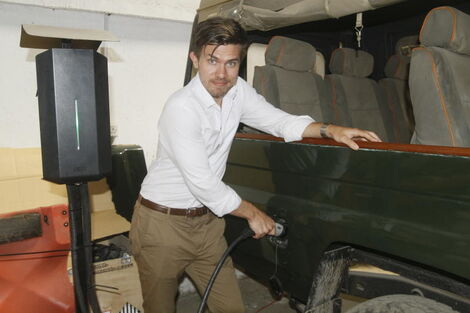- Details
- Julius Mbaluto
- East Africa
- 1171
-
Viju Patel (right) and his son Jayesh Patel (left) pose with the Tesla Model X 75D COURTESY
-
Kenya's first Tesla owner, Viju Patel has shared the experience of importing and owning the Ksh13 million electric vehicle. On Monday, November 2, his car caused a buzz online after it was spotted being towed on a Kenyan highway.
Patel detailed that he imported the car directly from London, UK, four years after he got interested in owning the vehicle. However, his family opposed his decision as they raised concerns on maintenance, after-sales support and repair.
"I just wanted the best electric car. I didn’t worry too much about the price tag, I just wanted to own one," the car enthusiast said.
His son, Jayesh Patel, guided him on the model he would purchase and the two opted for Tesla Model X 75D which was shipped from London. He also bought a single-phase charger for his home and a 3-phase Level 2 charger for his office.
A Tesla car spotted in Kenya in November 2020TWITTERPatel added that the toughest challenge he faced was clearing the vehicle at the customs department and having it registered. The process was quite frustrating as the officials were astounded by the car's aspects.
"They kept asking what is the vehicle’s CC’/engine capacity and stuff like that. They also took a while to clear the car, as they wanted to ensure they captured everything correctly, including the import duties and taxes for this type of car," Patel said.
The car's suspensions were one of the features that particularly impressed him. Model X 75D comes in two types, the Long Range and Plaid. The top speeds range at 250 km/h and 262 km/h and can travel up to 580 kilometres and 550 kilometres respectively after charging.
Long Range model accelerates at 0-96 kilometres in 3.8 seconds with Plaid accelerating at the same distance in 2.5 seconds. Both come with Tesla's Autopilot driver assistance and GPS systems.
As of 2019, there were only 300 electric vehicles in the country. Kenya seeks to have 5 percent of all registered vehicles in Kenya being electric vehicles, by 2025.
The government wants to reduce congestion on roads and emissions of exhaust gases, a plan which fits into Kenya’s National Climate Change Action Plan (NCCAP 2018-2023). The NCCAP identified operational inefficiencies in the transport sector, heavy traffic congestion, and high fuel consumption as a major contributor to high levels of emissions.
Kenya also enjoys geothermal, wind, utility-scale solar, and hydropower plants which can facilitate a conversion, the alternative way of owning an EV apart from purchasing one. Opibus, based in Industrial Area, Nairobi, converts fuel automobiles to EVs.
Nopea Ride which was launched in the country in 2018 also converts cars and offers electric taxi services in Nairobi. Nopea has charging stations at TRM along Thika Road, The Hub in Karen and Two Rivers Mall. Motorists can also charge the vehicles at home once they install a charging point.
 Opibus CEO Filip Gardle recharges an electric car at their workshop in Embakasi, NairobiTHE STANDARD
Opibus CEO Filip Gardle recharges an electric car at their workshop in Embakasi, NairobiTHE STANDARD











